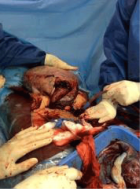Abstract
Research Article
An Observational Study on Clinical Outcome and Predictors of Traumatic Cervical Injury at a Tertiary Care Facility
Surendra Saini, Ankit Prajapati, Ina Bahl*, Deepika Gehlot and Namita Prajapati
Published: 26 March, 2025 | Volume 9 - Issue 1 | Pages: 028-038
Introduction: Cervical spinal cord injuries (CSIs) account for 2% - 3% of trauma cases and 8.2% of trauma- related fatalities, making them a significant cause of disability and mortality. Effective management and timely interventions are essential to improve neurological and functional outcomes. This study aimed to evaluate the outcomes of patients with CSIs and identify key predictors of neurological and functional improvement.
Materials and methods: This prospective observational study was conducted over 12 months at SMS Medical College, Jaipur, involving 100 patients with CSIs from C1 to C7 vertebrae. Patients presenting within one week of injury were included. Clinical evaluation was conducted using the ASIA scoring system, and functional outcomes were assessed with the Functional Independence Measure (FIM) scale. MRI findings were analyzed to classify injuries and identify critical predictors, including the presence and extent of edema and listhesis grading.
Results: Significant predictors of neurological improvement included injury type, management approach, MRI findings, extent of edema (≤ 2 vs. >2 segments), and listhesis grading. Operative management and incomplete injuries showed better outcomes. The median Barthel Index improved from 4.0 preoperatively to 7.0 at four months (p < 0.001). The mean FIM score also significantly increased from 43.25 ± 26.5 to 56.8 ± 40.75 (p < 0.05). ASIA Grades C and D demonstrated significant neurological recovery, with no grade deterioration observed.
Conclusion: Age, injury type, management strategy, MRI findings, extent of edema, and listhesis grading are key predictors of outcomes in CSIs. These findings emphasize the importance of early diagnosis, timely surgical intervention, and comprehensive management in improving neurological and functional recovery. Multicentric studies with larger cohorts are recommended for broader generalizability.
Read Full Article HTML DOI: 10.29328/journal.jnnd.1001107 Cite this Article Read Full Article PDF
References
- World Health Organization. Spinal cord injury: Fact sheet. WHO Newsroom. 16 April 2024. Available from: https://www.who.int/news-room/fact-sheets/detail/spinal-cord-injury#:~:text=Key%20facts,violence%2C%20and%20are%20thus%20preventable.
- Pandrich MJ, Demetriades AK. Prevalence of concomitant traumatic cranio-spinal injury: A systematic review and meta-analysis. Neurosurg Rev. 2020;43(1):69–77. Available from: https://doi.org/10.1007/s10143-018-0988-3
- Stewart AN, Jones KB, Gensel JC. Improving translatability of spinal cord injury research by including age as a demographic variable. Front Cell Neurosci. 2022;16:017153. Available from: https://doi.org/10.3389/fncel.2022.1017153
- Jaiswal SK, Ojha BK, Jaiswal S, Bajaj A. Clinical outcome and predictors of traumatic cervical injury: A prospective observational study. Asian J Neurosurg. 2024;19(4):641–649. Available from: https://doi.org/10.1055/s-0044-1788062
- Tarawneh AM, D’Aquino D, Hilis A, Eisa A, Quraishi NA. Can MRI findings predict the outcome of cervical spinal cord injury? A systematic review. Eur Spine J. 2020;29(10):2457–2464. Available from: https://doi.org/10.1007/s00586-020-06511-7
- Boldin C, Raith J, Fankhauser F, Haunschmid C, Schwantzer G, Schweighofer F. Predicting neurologic recovery in cervical spinal cord injury with postoperative MR imaging. Spine. 2006;31(5):554–559. Available from: https://doi.org/10.1097/01.brs.0000201274.59427.a4
- Yousefifard M, Hashemi B, Rahimi-Movaghar V. Ultra-early spinal decompression surgery can improve neurological outcome of complete cervical SCI: A systematic review and meta-analysis. World Neurosurg. 2022;159:e410–e422.
- Martínez-Pérez R, Fuentes F, Alemany VS. Subaxial cervical spine injury classification system: Is it most appropriate for classifying cervical injury? Neural Regen Res. 2015 Sep;10(9):1416-7. Available from: https://doi.org/10.4103/1673-5374.165508
- Srinivas B, Rajesh A, Purohit A. Factors affecting outcome of acute cervical spine injury: A prospective study. Asian J Neurosurg. 2017;12(03):416-423. Available from: https://doi.org/10.4103/1793-5482.180942
- Hitti FL, Mcshane BJ, Yang AI, Rinehart C, Albayar A, Branche M, et al. Predictors of neurological outcome following subaxial cervical spine trauma. Cureus. 2019 Dec 17;11(12):e6402. Available from: https://doi.org/10.7759/cureus.6402
- Tsalimas G, Alvanos D, Kalmantos T. Dysphagia as a postoperative complication of anterior cervical discectomy and fusion (ACDF): A literature review. Cureus. 2022;14(8):e27798.
Figures:
Similar Articles
-
Analysis of early Versus Delayed Carotid Surgery after Acute Ischemic StrokePEROU Sébastien*,DETANTE Olivier,SPEAR Rafaelle,PIRVU Augustin,ELIE Amandine,MAGNE Jean-Luc. Analysis of early Versus Delayed Carotid Surgery after Acute Ischemic Stroke. . 2017 doi: 10.29328/journal.jnnd.1001001; 1: 001-011
-
The “Calcium Paradox” Due To Ca2+/Camp Interaction: New Insights for the Neuroscience FieldLeandro Bueno Bergantin*, Afonso Caricati-Neto. The “Calcium Paradox” Due To Ca2+/Camp Interaction: New Insights for the Neuroscience Field. . 2017 doi: 10.29328/journal.jnnd.1001002; 1: 012-015
-
Protective functions of AEURA in Cell Based Model of Stroke and Alzheimer diseaseJigar Modi,Ahmed Altamimi,Ashleigh Morrell,Hongyuan Chou,Janet Menzie,Andrew Weiss,Michael L Marshall, Andrew Li,Howard Prentice*,Jang-Yen Wu*. Protective functions of AEURA in Cell Based Model of Stroke and Alzheimer disease. . 2017 doi: 10.29328/journal.jnnd.1001003; 1: 016-023
-
Direct Carotid Puncture for Flow Diverter Stent InsertionBhogal P*,Phillips TJ, Makalanda HLD. Direct Carotid Puncture for Flow Diverter Stent Insertion. . 2017 doi: 10.29328/journal.jnnd.1001004; 1: 024-028
-
Lateralized Cerebral Amyloid Angiopathy presenting with recurrent Lacunar Ischemic StrokeYi Li*, Ayman Al-Salaimeh,Elizabeth DeGrush,Majaz Moonis*. Lateralized Cerebral Amyloid Angiopathy presenting with recurrent Lacunar Ischemic Stroke. . 2017 doi: 10.29328/journal.jnnd.1001005; 1: 029-032
-
Experimental ‘hindbrain related’ syringomyelia: some mechanisms of spinal cord damageSergey N Larionov*,Sorokovikov VA,Rudakova AV. Experimental ‘hindbrain related’ syringomyelia: some mechanisms of spinal cord damage. . 2017 doi: 10.29328/journal.jnnd.1001006; 1: 033-038
-
Focal Ab-amyloid deposition precedes cerebral microbleeds and Superficial siderosis: a case reportParnesh Raniga,Patricia Desmond, Paul Yates,Olivier Salvado, Pierrick Bourgeat,Jurgen Fripp,Svetlana Pejoska, Michael Woodward,Colin L Masters,Christopher C Rowe,Victor L Villemagne*. Focal Ab-amyloid deposition precedes cerebral microbleeds and Superficial siderosis: a case report. . 2017 doi: 10.29328/journal.jnnd.1001007; 1: 039-044
-
Comorbidity of alcohol dependence with attention-deficit/hyperactivity disorder and the role of executive dysfunctionsCaterina Pistarini*,Gloria Tosi,Giovanni Vittadini,Ines Giorgi,Elena Fiabane,Paola Palladino. Comorbidity of alcohol dependence with attention-deficit/hyperactivity disorder and the role of executive dysfunctions . . 2018 doi: 10.29328/journal.jnnd.1001008; 2: 001-010
-
Spinal muscular atrophy counteracted by Agrin biological NT-1654Jes Paul*. Spinal muscular atrophy counteracted by Agrin biological NT-1654. . 2018 doi: 10.29328/journal.jnnd.1001009; 2: 011-013
-
Brain and immune system: KURU disease a toxicological process?Luisetto M*,Behzad Nili-Ahmadabadi,Ghulam Rasool Mashori,Ahmed Yesvi,Ram Kumar Sahu,Heba Nasser,Cabianca luca,Farhan Ahmad Khan. Brain and immune system: KURU disease a toxicological process?. . 2018 doi: 10.29328/journal.jnnd.1001010; 2: 014-027
Recently Viewed
-
Sinonasal Myxoma Extending into the Orbit in a 4-Year Old: A Case PresentationJulian A Purrinos*, Ramzi Younis. Sinonasal Myxoma Extending into the Orbit in a 4-Year Old: A Case Presentation. Arch Case Rep. 2024: doi: 10.29328/journal.acr.1001099; 8: 075-077
-
The relationship between IT consumption and anxiety in Pakistani youthWaqar Husain*,Sehrish Mobeen. The relationship between IT consumption and anxiety in Pakistani youth. Arch Psychiatr Ment Health. 2020: doi: 10.29328/journal.apmh.1001026; 4: 084-086
-
A Gecko-eye View of Naturalistic EnclosuresVictoria Davies, Abigail Heaman, James Brereton*. A Gecko-eye View of Naturalistic Enclosures. Insights Biol Med. 2023: doi: 10.29328/journal.ibm.1001026; 7: 013-019
-
Success, Survival and Prognostic Factors in Implant Prosthesis: Experimental StudyEpifania Ettore*, Pietrantonio Maria, Christian Nunziata, Ausiello Pietro. Success, Survival and Prognostic Factors in Implant Prosthesis: Experimental Study. J Oral Health Craniofac Sci. 2023: doi: 10.29328/journal.johcs.1001045; 8: 024-028
-
Bleeding from Varices: Still a Heavy Burden in Patients with CirrhosisAmitrano L*, Guardascione MA, Saviano S, Martino A, Lombardi G. Bleeding from Varices: Still a Heavy Burden in Patients with Cirrhosis. Ann Clin Gastroenterol Hepatol. 2023: doi: 10.29328/journal.acgh.1001043; 7: 035-037
Most Viewed
-
Evaluation of Biostimulants Based on Recovered Protein Hydrolysates from Animal By-products as Plant Growth EnhancersH Pérez-Aguilar*, M Lacruz-Asaro, F Arán-Ais. Evaluation of Biostimulants Based on Recovered Protein Hydrolysates from Animal By-products as Plant Growth Enhancers. J Plant Sci Phytopathol. 2023 doi: 10.29328/journal.jpsp.1001104; 7: 042-047
-
Sinonasal Myxoma Extending into the Orbit in a 4-Year Old: A Case PresentationJulian A Purrinos*, Ramzi Younis. Sinonasal Myxoma Extending into the Orbit in a 4-Year Old: A Case Presentation. Arch Case Rep. 2024 doi: 10.29328/journal.acr.1001099; 8: 075-077
-
Feasibility study of magnetic sensing for detecting single-neuron action potentialsDenis Tonini,Kai Wu,Renata Saha,Jian-Ping Wang*. Feasibility study of magnetic sensing for detecting single-neuron action potentials. Ann Biomed Sci Eng. 2022 doi: 10.29328/journal.abse.1001018; 6: 019-029
-
Pediatric Dysgerminoma: Unveiling a Rare Ovarian TumorFaten Limaiem*, Khalil Saffar, Ahmed Halouani. Pediatric Dysgerminoma: Unveiling a Rare Ovarian Tumor. Arch Case Rep. 2024 doi: 10.29328/journal.acr.1001087; 8: 010-013
-
Physical activity can change the physiological and psychological circumstances during COVID-19 pandemic: A narrative reviewKhashayar Maroufi*. Physical activity can change the physiological and psychological circumstances during COVID-19 pandemic: A narrative review. J Sports Med Ther. 2021 doi: 10.29328/journal.jsmt.1001051; 6: 001-007

HSPI: We're glad you're here. Please click "create a new Query" if you are a new visitor to our website and need further information from us.
If you are already a member of our network and need to keep track of any developments regarding a question you have already submitted, click "take me to my Query."















































































































































